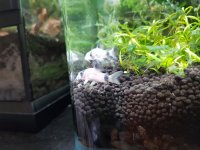Not wanting to derail this thread but having watched and read the responses it’s opened my eyes to how incredibly fickle and difficult this hobby can be.
Plant your plants, add some ferts and you too can have a tank similar to the photos you’ve seen.
Nope, sorry, don’t work like that.
Maybe as a newbie I’ve been blind to see what’s blatantly obvious to others but
@Witcher post above has been somewhat of a lightbulb moment. It’s made me realise how little I know and how far I have to go before I stand a cat in hells chance of having the tank I desire



